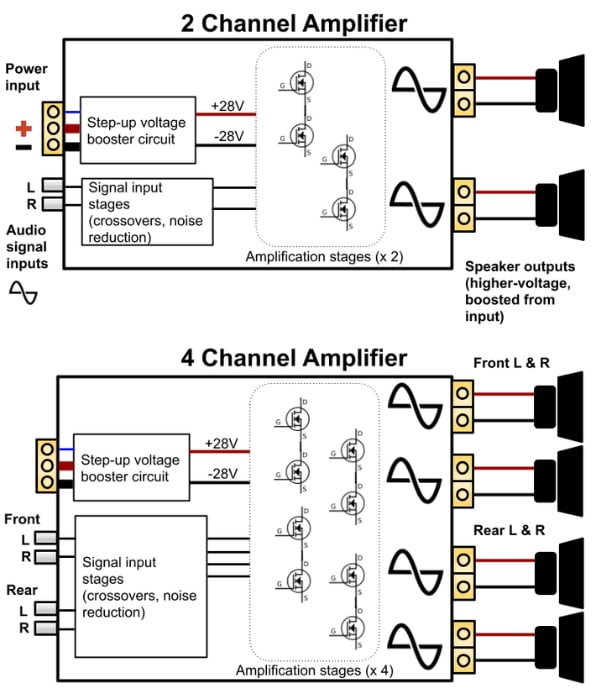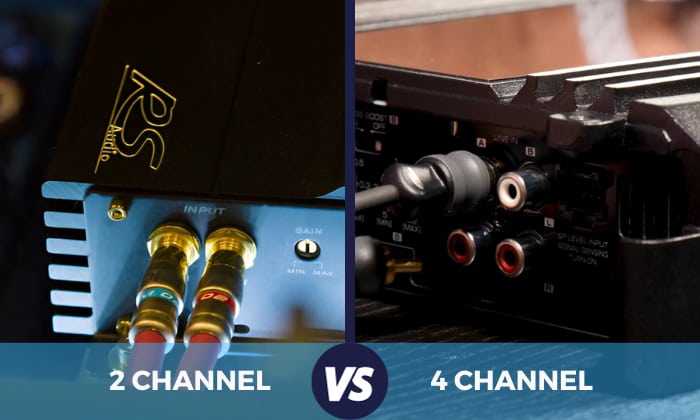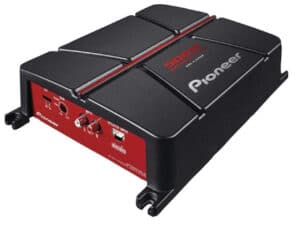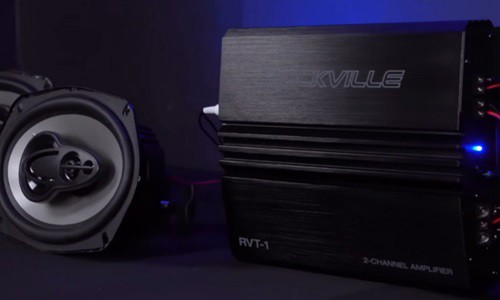We add an amplifier (amp) to the sound system to enjoy the best music quality. In its simplest terms, an amplifier magnifies an audio signal. It takes a low-level signal from a source and amplifies it for better speaker outputs.
In other words, these channels act like highways to direct sound toward the speakers. More channels mean more audio lanes to channel sound to more speakers. This paves the way for interactive and enveloping sound experiences.
If you find yourself contemplating over 2-channel vs 4-channel amps, this article provides the exact information. We’ll explore their differences and the best option for you.
Before we get into the specifics, here’s a quick summary of the differences between these two channel configurations.
| Features | 2-Channel Amp | 4-Channel |
| Channel number | Two | Four |
| Speaker support | Powers 2 speakers | Powers up to 8 speakers |
| Ease of installation | Easier due to fewer channels | More complex |
| Ideal for | Simple stereo systems, single subwoofers | Surround sound systems, car audio systems, speakers with subwoofers |
Table of Contents
Amplifier Channels Explained
So, what is a 2-channel amplifier and a 4-channel amplifier?
Also known as a stereo amplifier, a 2-channel amp is a device that can deliver power independently to two separate speakers or channels. This means it has a couple of outputs, one for powered each speaker.
A 4-channel vs 2-channel amp delivers interactive sound experiences for stereo systems, front speakers, a pair of speakers, or even bridged to act as a monoblock amplifier to feed a subwoofer.
The two channels correspond to the left and right channels of a stereo sound. This ability allows a 2-channel amp to build a soundstage that gives a depth for some rocking music.
On the other hand, a 4-channel amplifier or quadraphonic sound is an intricate version of a 2-channel amp. It has four separate audio signals that can power multi-speakers independently.
In a car audio system, for example, it can power both the front and rear speakers while maintaining independent control over each. Alternatively, two channels can power speakers while the remaining two (when bridged) can power a subwoofer.
If you use a 4-channel amp, you’ll be impressed by how it creates high-quality, crystal-clear sounds. It can effortlessly handle surround sound, hall, cinema, and home theater systems.
Each speaker receives a higher sound signal from each input. This feature simulates sound effects for immersive moments when watching movies or listening to instrumental music.
Differences Between 4-Channel Amp vs 2-Channel
There are several notable distinctions between 2-channel and 4-channel amps. Let’s explore each of them below:
1. Wiring and Configuration
As noted, 2-channel amplifiers can power a pair of speakers, with each channel associated with a single speaker. The available channels allow limited options for wiring and configuration.
Conversely, a 4-channel amp holds greater flexibility in terms of wiring and connectivity. And we agree with what this one Reddit user said:
The ability to connect to multi-devices distinctly empowers it to deliver more differentiated audio frequencies, creating a fuller and more nuanced music experience.
Here’s a helpful wiring diagram for each type of amplifier:

2. Power Ratings
Each channel on an amplifier has its unique power output specifications, measured in watts. When shopping, it’s best to examine the Root Mean Square (RMS) value, as this metric indicates the continuous power that an amplifier can sustain.
According to our experiences, 50 RMS to 100 RMS is the ideal range for each channel. For beginners, it would be best to start with 50.
As they are suitable for typical stereos, 2-channel amps usually have lower wattage distributed over two channels. Meanwhile, a 4-channel amp has higher power ratings divided across four lanes.
Generally, power ratings differ by how the power is assigned across channels and the setup options provided, whether standard or bridged.
3. Sound Quality
Generally, both options can deliver high-quality sounds. However, a 2-channel amp is less flexible in distributing frequencies across multiple speakers. It might be an unfitting option if you want to create more depth and energy in your sound experience.
A 4-channel amplifier allows for better sound coverage and separation of audio frequencies across multiple speakers. With separate speakers handling different frequency bands, it boosts audio output for crisper, louder sounds.
Which Amplifier is Best, 2-Channel or 4-Channel?
There is no definitive answer to whether a 2-channel or a 4-channel amplifier is better since both have distinct strengths and ideal applications. Your decision primarily depends on your system’s specific needs and audio preferences.
1. Amplifier type for your existing speakers or subwoofers
It’s crucial to match the amplifier requirement to your current sound system. For a simple stereo configuration (only two speakers), a 2-channel amplifier will suffice.
Suppose you have multiple speakers or a combination of speakers and subwoofers, a 4-channel amp can offer more flexibility and control. Complex audio configurations requiring multiple connections also need a 4-channel amp.
2. The power ratings of your speakers
How powerful should your amp be? Typically, your choice should match your speakers’ RMS power handling range. This is to ensure optimal performance and longevity of your sound system.
For example, if you have 50 RMS speakers, a 50-watt amplifier is enough to feed your power-hungry equipment.
Higher than that, you’ll get poor sound quality and (eventually) a damaged speaker.
Other ideal applications for each option:
2-channel amp
You’ll love this amplifier setup if you enjoy listening to lively, amplified music.
- If you have a pair of high-output front speakers, this is your best bet.
- It is also ideal for full-range speaker systems, components with active crossovers, or subwoofers in bridged mode.
4-channel amp
- If you want to enjoy rear-filled sound in your car, this may be the best amp.
- This is a good choice if you prefer a louder and clearer sound from your home theater speakers.
- It’s also great when you want eye-popping music while camping outdoors.
Conclusion
When choosing between a 2-channel vs 4-channel amp, the number of speakers in your car or home theater and their wattage will determine which amp suits better. Also, your choice lies in understanding which amplifier aligns with your current needs and sound preferences.
Realistically, you can choose either option—however, the more channels and speakers, the louder and clearer the sound.
So, determining the perfect balance between amplifier capabilities and requirements will enable you to create an immersive and impactful music experience like never before!

Sam Stephenson is a writer who grew up in Washington, North Carolina. He was 2010 and 2015 ASCAP Deems Taylor / Virgil Thomson Prize winner and a 2019-2020 Guggenheim Fellow in General Nonfiction. His books have been published by W.W. Norton, Alfred A. Knopf, and Farrar, Straus and Giroux





